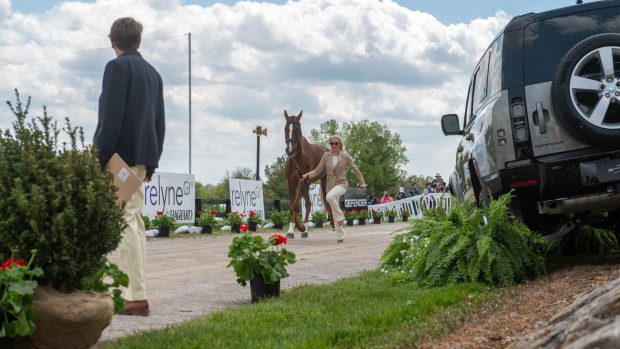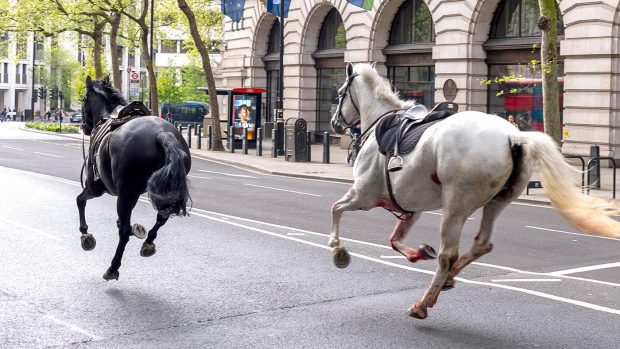A renowned British explorer who describes her many travels on horseback as a “way of life” has recently returned from her latest trek.
Christina Dodwell travelled to India at the end of November to ride across Rajhastan on the rare Marwari horses. Starting her journey in the blue city of Jodhpur, which she describes as a “sensory barrage”, she took in miles of forts, palaces, semi-desert and forested mountains, concluding her trek in Udaipur.
“I’ve always wanted to go to Rajhastan, it’s been on my wish list for years,” said Christina, who began her epic horseback trips in 1975, travelling solo across Africa, Turkey, Iran and Papua New Guinea. “I’ve always been detoured to wider parts of the world, so it was brilliant to finally get the chance to go.”
While the 66-year-old broadcaster and author usually sources her equine travelling companions from local horse owners, this time she engaged the help of guide and Marwari breeder Ajeet Singh.
Eight generations of Ajeet’s family have been horse breeders and he owns the Jodha Stud, formerly a royal hunting lodge, which is home to 38 Marwaris, including two breeding stallions.
“On my last trip to Turkey and Iran I kept getting arrested, so this time I thought I’d engage a guide for the first time,” Christina explained. “Ajeet knew I was fit and up for adventure.”
The spirited Marwaris brought their own flavour to the trip, adding to the variety of horses she has had as travelling companions over the decades.
In South Africa, she bought a horse at a sale for the “dreg ends” as she was short of money, for £30.
“I had no money for a saddle and bridle, so I made one from string and put my sleeping bag on the horse’s back,” she said.
In New Guinea she was lent one of her favourite rides, a grey stallion.
“A coffee farmer who was closing up a plantation said they couldn’t take the stallion with them and asked if I could take him away and bring him back when the mares were settled,” she said.
“Other places I bought horses that were mostly the kind they couldn’t ride. If you ride with a horse like that, everything around them is constantly changing and nothing is the same except you —you are the only constant, so you build up an extraordinary bond, even with horses that are quite difficult.”
Ajeet’s Marwaris, on the other hand, had “beautiful manners”and were well-suited to long-distance riding, proving themselves eager and with ample stamina.
“They’re comfortable but very hot,” Christina said. “Even walking they travel with 10 times the speed and interest of other horses; all their paces are feisty.”
The warrior breed’s trademark inwardly curved eartips were also a distinct feature.
“They can rotate them completely, even one at a time, whereas other horses just twitch them backwards and forwards,” she added. “I was amazed by the way they listened to me constantly, with the ears continually moving.
“They’d know in advance when wild animals were near, like the wild camels in the desert’s acacia thickets, and the antelope; my horse sensed them long before I saw them bounding away.”
Historically bred for battle, the Marwaris’ bravery was also apparent in some of the riskier situations they encountered.
“In one of the snake charmer villages we were attacked by a bull, quite a surprise since normally the cattle move out of your way or you go round them. As the bull lowered his horns and stamped toward my horse, Ajeet nobly pushed his horse to confront the bull. Ever the warrior! Dogs rushed into the fray and the bull finally backed off,” she recalls.
On another day, they were following a rocky track through forested mountains — with no habitation other than the occasional abandoned hunting tower visible through the trees — when they reached a collapsed section of the pathway.
“It had collapsed at a precipitous bend and we dismounted. Ajeet suggested we could pass if we edged through hard against the bushes, leading our horses at full rein stretch in case the path collapsed. A glance at the height of the fall made me shudder. Although I’m not used to having a guide, I did appreciate my warrior. His calm ability got us past this obstacle and others.” she adds.
Even though the areas she passed through were often more modern than she anticipated — with tractors commonly in use for farming — Christina observed that horses had retained their cultural significance in India despite shifting times.
“Every important building has enormous murals on the side of horses. The horse represents power, the elephant represents strength and the camel, love,” she explains. “The horse’s position of power is of such historical importance…. it was what brought the armies through, it was how communications worked. Horses were a means of getting everywhere far more recently than in our country.
“They are still used in the towns to pull carts and tourist wagons, even tuk tuks, but in general they are so esteemed that they are still in use for ceremonial and important occasions.”
Christina was able to witness one of these first-hand, when on her last day she came across an elephant being saddled for a wedding procession.
“Nearby were two milky white Marwari dancing horses. I asked to see one dance and the moment the musicians struck up the rhythm both horses began to dance, the second one refusing to be left out, so stirred by the music his hooves couldn’t stay still.
“They pranced and did pirouettes and levees, not the most accurate of moves but so eager. Suddenly the music increased with trumpets and more drums, people began dancing and the wedding began,” she remembers.
Article continues below…
Explorer’s 8,000 mile horseback odyssey nears conclusion
An epic solo horseback journey from Mongolia to Hungary is drawing to a conclusion for an Australian adventurer.

Pub marks halfway point for horseback odyssey
Charity rider Grant Nicolle has reached the halfway point on his epic 1,300 mile journey from John O’ Groats to
While her latest journey may have been less fraught than some of her other adventures, it clearly remains just as a vivid an experience.
“In context, I’ve been attacked by bandits, arrested as a spy, bitten by hunting spiders and threatened but I’ve never needed to call for foreign assistance,” she says.
India, however, was simply “hard to leave”.
“It was such a different ride from those I’ve made in the past, but it surpassed my dreams.”
For all the latest news analysis, competition reports, interviews, features and much more, don’t miss Horse & Hound magazine, on sale every Thursday.





